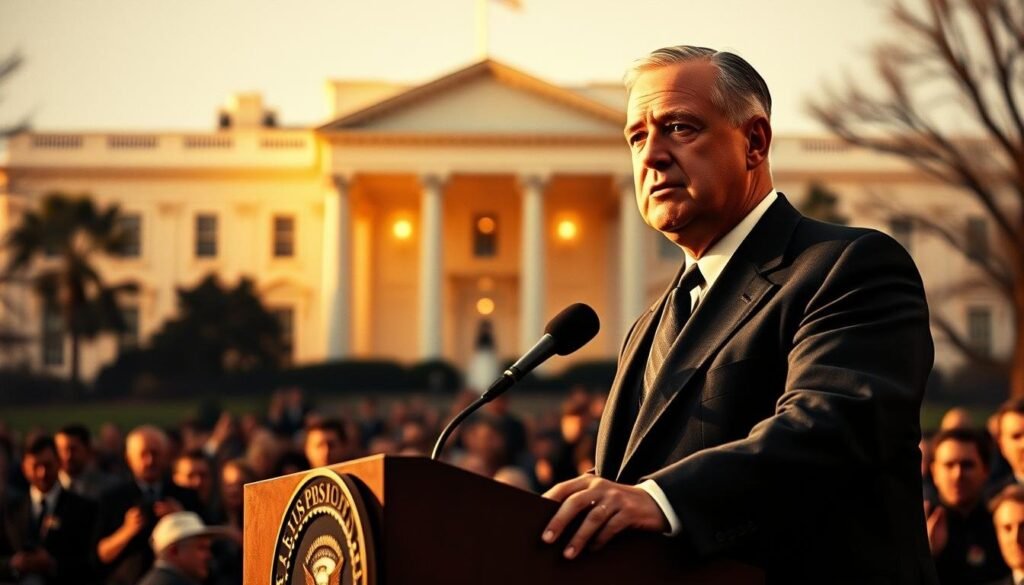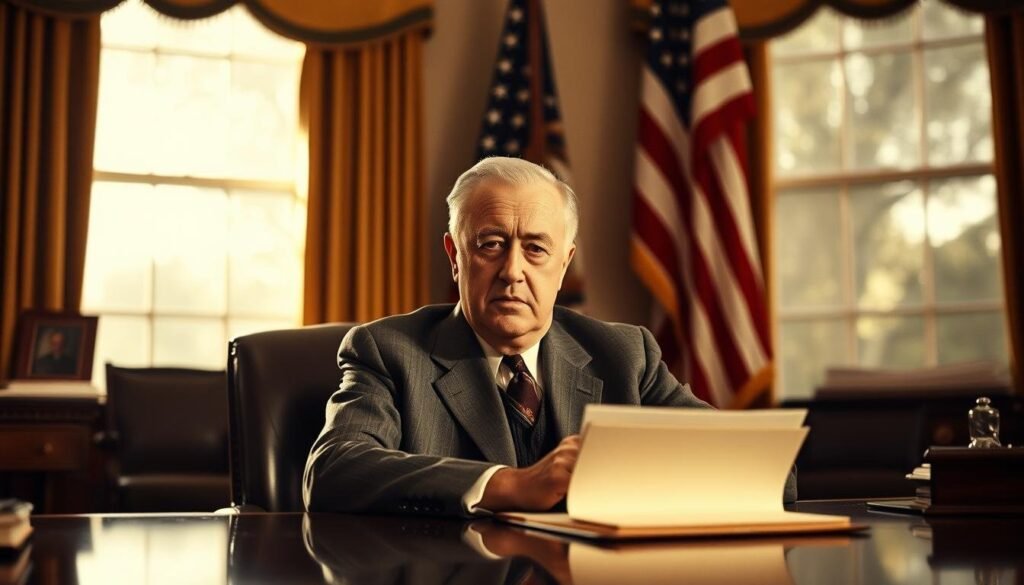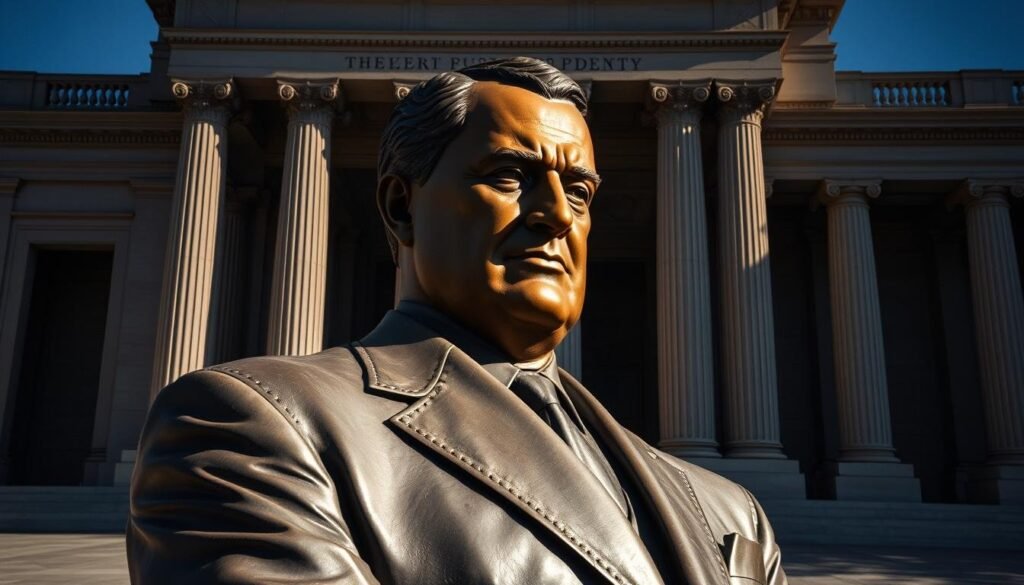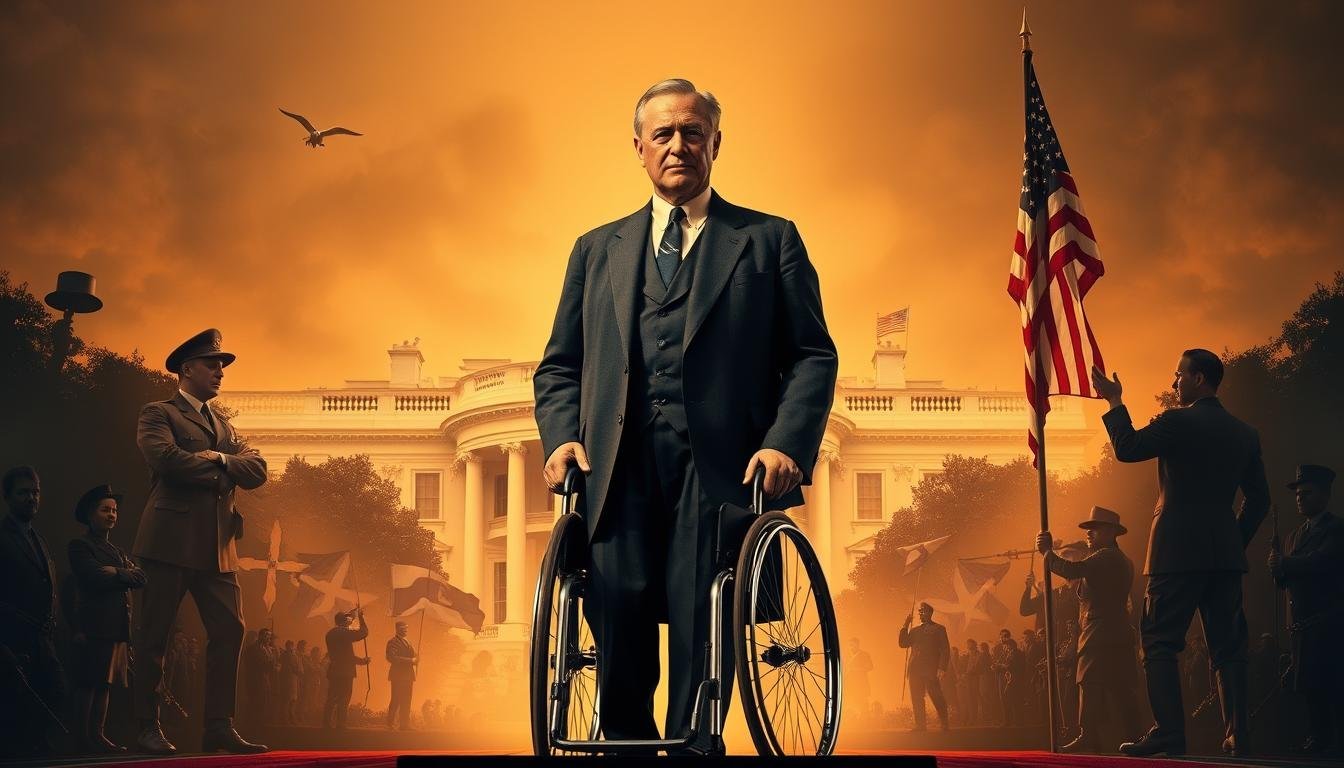Why Did FDR Serve 4 Terms as President? Have you ever wondered why Franklin D. Roosevelt was president for four terms in a row? This introduction will take you through the history and reasons behind this unique event in American politics.
The story of FDR’s long presidency is fascinating. It shows how the Great Depression and World War II changed how Americans saw leadership. These events made people value stability and strong leadership more than ever.
As you learn more, you’ll see how these events led to a big change in the U.S. Constitution. This change has had a lasting impact on how presidents lead the country.
Contents
- 1 The Historical Precedent of Presidential Terms
- 2 Notable Presidential Succession Patterns
- 3 Franklin D. Roosevelt’s Rise to Political Power
- 4 The Great Depression and FDR’s First Election
- 5 First Term Achievements: The New Deal
- 6 Building a Coalition of Support
- 7 Second Term and Continued Economic Challenges
- 8 Court-Packing Controversy
- 9 Why Did FDR Serve 4 Terms as President?
- 10 Third Term: Breaking Tradition Amid Global Crisis
- 11 Fourth Term and FDR’s Final Years
- 12 The 22nd Amendment: Roosevelt’s Legacy on Term Limits
- 13 Historical Perspectives on Roosevelt’s Extended Presidency
- 14 Conclusion: Why Did FDR Serve 4 Terms as President?
- 15 FAQ
- 15.1 Why did Franklin D. Roosevelt serve four terms as President of the United States?
- 15.2 What was the historical context that allowed FDR to serve four terms?
- 15.3 How did FDR’s leadership style contribute to his electoral success?
- 15.4 What was the significance of FDR’s “New Deal” platform?
- 15.5 How did the global crisis of World War II impact FDR’s decision to run for a third term?
- 15.6 What were the implications of FDR’s extended presidency for future presidents?
- 15.7 Could a president serve four terms again in the future?
- 15.8 How did FDR’s health impact his ability to lead during his fourth term?
The Historical Precedent of Presidential Terms
The idea of presidential terms being limited to two wasn’t always set in stone. It was largely based on George Washington’s choice to step down after two terms. This choice set a precedent that many future presidents followed.
But, not all presidents stuck to this rule. For example, Ulysses S. Grant wanted a third term. Though he failed, it showed the need for clear term limits in the United States. [Why Did FDR Serve 4 Terms as President?]
Notable Presidential Succession Patterns
Over time, different presidential succession patterns emerged. Some, like Theodore Roosevelt, finished their predecessor’s term and then ran for two full terms themselves.
- Some presidents died in office, leading to vice presidential succession.
- Others resigned, as seen in the case of Richard Nixon.
- A few tried to go beyond the two-term limit but faced opposition.
These patterns show how presidential terms have changed over time. They highlight the need for a constitutional amendment to establish term limits. The story of FDR’s four terms is a key part of this history.
Franklin D. Roosevelt’s Rise to Political Power
FDR’s journey to power was fueled by his political smarts and his ability to connect with people. The Great Depression hit hard, but FDR’s leadership and vision for a better future won over many.
FDR was known for his exceptional communication skills and understanding of everyday struggles. His ‘Fireside Chats’ were a way to talk directly to the nation. He offered hope and shared his plans to tackle the economic crisis.
His leadership was more than just policy; it was about hope and unity. FDR’s optimism was infectious. His bold approach to solving the Depression made people believe in him.
The factors that made FDR so appealing include:
- A charismatic personality that inspired confidence
- Effective communication that resonated with the public
- A willingness to innovate and take bold action
These qualities, along with the dire times of the Great Depression, made FDR incredibly popular. This set the stage for his four terms in office.
The Great Depression and FDR’s First Election
The Great Depression hit America hard. Franklin D. Roosevelt promised a ‘New Deal’ to the people. The country was jobless and felt hopeless.
The 1932 election was a big moment. People wanted change from old policies. FDR said he would bring a ‘New Deal’ to help America.
Roosevelt’s Promise of a “New Deal”
FDR’s ‘New Deal’ aimed to help those hit by the Great Depression. It included jobs, financial fixes, and social help. [Why Did FDR Serve 4 Terms as President?]
The ‘New Deal’ was more than policies. It was a beacon of hope. It showed a new way for the government to handle tough times. Many saw it as a better choice than what came before.
In the election campaign, FDR talked about quick action. He said the New Deal would lift America out of trouble.
In the end, FDR won because of his ‘New Deal’ ideas. The Great Depression had left people in a bad spot. FDR’s promise of a New Deal gave them hope for a brighter future.
First Term Achievements: The New Deal
When FDR took office, he started the New Deal. This was a big set of reforms to help the Great Depression. It changed how the government handled economic problems.
The New Deal included the Civilian Conservation Corps (CCC), the Works Progress Administration (WPA), and the National Recovery Administration (NRA). These groups gave jobs, built things, and brought hope to many.
Building a Coalition of Support
FDR was great at getting people to support him. He worked with labor unions, farmers, and city folks. This support helped pass important laws and programs.
The New Deal’s effects are shown in this table. It lists some key programs and what they did:
| Program | Purpose | Achievements |
|---|---|---|
| Civilian Conservation Corps (CCC) | Job creation and conservation | Employed over 3 million young men in conservation projects |
| Works Progress Administration (WPA) | Infrastructure and job creation | Built over 600 airports, 125,000 public buildings, and 75,000 bridges |
| National Recovery Administration (NRA) | Economic recovery and labor reform | Established minimum wage and working conditions, codes of fair competition |
The New Deal helped with immediate economic needs. It also changed how the government and people interacted. FDR’s leadership in his first term set the stage for his future wins. [Why Did FDR Serve 4 Terms as President?]
Second Term and Continued Economic Challenges
When FDR won his second term, he faced new hurdles. The economy was still struggling with high unemployment and slow growth. Despite the progress from his first term, more work was needed.
Economic Challenges were a big focus for FDR in his second term. He brought in new policies to help the economy recover. These included plans to tackle unemployment and fix financial systems.
Court-Packing Controversy
The court-packing plan was a major controversy in FDR’s second term. He wanted to add more justices to the Supreme Court to support his New Deal policies.
- The plan was strongly opposed by conservatives and some liberals.
- They saw it as a threat to the balance of power.
- In the end, the court-packing plan was defeated.
The court-packing controversy hurt FDR’s political standing. Though the plan failed, it showed the deep political divisions of the time. It also highlighted the challenges FDR faced in pushing through his policies.
FDR’s second term was filled with both successes and setbacks. The ongoing economic troubles and the court-packing controversy were key issues. These challenges defined his presidency during this period.
Despite these obstacles, FDR stayed true to his goal of economic recovery and reform. His leadership during this time is still studied by historians and political analysts today.
Why Did FDR Serve 4 Terms as President?
You might wonder why Franklin D. Roosevelt broke the tradition of serving only two terms as president. This was both remarkable and controversial. The answer lies in the extraordinary circumstances of his time in office.
Leadership During Crisis: FDR’s leadership during the Great Depression and World War II was key. The American public sought stability and continuity. FDR’s policies, like the New Deal, offered hope and direction.

The ongoing crises led to a need for consistent leadership. Here are some key factors that contributed to FDR’s extended tenure:
- The Great Depression required sustained economic reform and recovery efforts.
- World War II demanded continuous leadership as the U.S. played a crucial role in the global conflict.
- FDR’s New Deal policies had a significant impact on the American public, creating a sense of reliance on his leadership.
These factors, along with FDR’s charismatic leadership and the public’s trust, led to his unprecedented four terms. The question of why did FDR serve 4 terms as president is tied to the historical context and the public’s perception of his leadership during times of great need.
In conclusion, FDR’s decision to serve four presidential terms was a response to the extraordinary challenges faced by the United States. His leadership during the Great Depression and World War II, along with the public’s desire for stability, made his extended tenure possible.
Third Term: Breaking Tradition Amid Global Crisis
The World War II crisis led FDR to seek a third term as President. The war in Europe made strong leadership crucial. [Why Did FDR Serve 4 Terms as President?]
FDR’s choice was not easy, as it defied George Washington’s two-term rule. Yet, the crisis made his leadership seem vital.
Roosevelt as Commander-in-Chief
As commander-in-chief, FDR was key in shaping the Allied strategy. He provided leadership during a time of great uncertainty. His role went beyond military plans; he also mobilized the economy and society for war.
- He implemented policies to boost industrial production and employment.
- FDR worked closely with other world leaders to coordinate Allied efforts.
- He ensured that the U.S. military was adequately prepared for the challenges ahead.
The crisis demanded a strong response, and FDR’s leadership was seen as critical. His role as commander-in-chief during World War II showed his leadership’s importance.
In conclusion, FDR’s decision to run for a third term was driven by the need for stability and strong leadership during a global crisis. His role as commander-in-chief highlighted the importance of his continued leadership.
Fourth Term and FDR’s Final Years
By the time FDR was elected for his fourth term, his health was failing. Despite his poor health, he stayed committed to his duties. He did this, even though he couldn’t do as much as before.
FDR faced many challenges in his fourth term. He had to lead the country through the end of World War II. At the same time, his health made it hard for him to do his job well.
Key Challenges During FDR’s Fourth Term:
- Managing the final stages of World War II
- Dealing with the physical and mental strain of his declining health
- Maintaining his influence within the government despite his weakened state
FDR’s health issues affected his leadership a lot. Many people worried if he could keep being President. But FDR stayed in office until his death. [Why Did FDR Serve 4 Terms as President?]
| Year | Event | Impact on FDR’s Presidency |
|---|---|---|
| 1944 | Elected for a fourth term | Continued leadership despite declining health |
| 1945 | Yalta Conference | Last major diplomatic effort before his death |
| April 1945 | FDR’s death | End of an era; transition of power to Truman |
FDR’s legacy is complex and lasting. He led the country through the Great Depression and World War II. His New Deal policies and leadership during these times made him a key figure in American history.

The 22nd Amendment: Roosevelt’s Legacy on Term Limits
After FDR’s long time in office, the 22nd Amendment was passed. It set a two-term limit for future presidents. This change was made to stop any president from having too much power for too long.
The 22nd Amendment changed presidential politics a lot. It showed the nation’s wish to go back to the two-term limit seen since George Washington. This limit was put in place to stop a long presidency like FDR’s.
The 22nd Amendment has big effects on future presidents. It makes sure the presidency is not held by one person for too long. This helps in keeping the power in check and brings in new ideas.
This rule also makes presidents think about their legacies differently. They aim to achieve a lot in their limited time. It also changes how the public and media see them, knowing their time is short.
The 22nd Amendment has also shaped American politics a lot. It affects how political parties plan and what candidates want. It shows the value of changing leaders and keeping the office fresh.
In summary, the 22nd Amendment is a key part of FDR’s legacy. It reminds us of the need for term limits in keeping democracy strong. It makes sure the presidency stays dynamic and changing.
Historical Perspectives on Roosevelt’s Extended Presidency
Roosevelt’s choice to stay in office beyond two terms has led to a lot of debate. Historians have looked closely at how his extended presidency affected American politics and government.
FDR’s leadership during the Great Depression and World War II is often seen as a reason for his long stay. His supporters say he kept America stable during tough times. But critics argue that his actions weakened the limits on the president’s power.

The 22nd Amendment to the U.S. Constitution, passed in 1951, deals with term limits for the president. It says no one can be elected president more than twice. [Why Did FDR Serve 4 Terms as President?]
This rule was made to stop a president from staying in office too long, like FDR did. It shows a shared belief in keeping the president’s power in check to avoid dictatorship.
In summary, FDR’s long presidency was a big event in history. But the constitutional safeguards today make sure it can’t happen again. Looking at these historical views and legal protections helps us understand how American politics has changed.
Conclusion: Why Did FDR Serve 4 Terms as President?
You’ve learned about the key reasons behind FDR’s four terms as president. His leadership during the Great Depression and World War II was crucial. Also, there were no term limits back then, which helped him stay in office longer.
FDR’s presidency greatly influenced American history. His New Deal programs and policies still shape today’s politics. This shows how his leadership during tough times has a lasting impact.
The 22nd Amendment, passed in 1951, set a two-term limit for presidents. This change came after FDR’s long time in office. It teaches us about the importance of term limits and leadership in crisis situations.
Reflecting on FDR’s presidency, we see his lasting impact on American governance and politics. His influence goes beyond his four terms, shaping the country’s future.
See Also: Why Was Reagan Called the “Teflon President”?
FAQ
Why did Franklin D. Roosevelt serve four terms as President of the United States?
Franklin D. Roosevelt served four terms because of his leadership during the Great Depression and World War II. At that time, there were no formal term limits.
What was the historical context that allowed FDR to serve four terms?
Before FDR, there was a two-term limit for U.S. presidents. But it wasn’t made official until the 22nd Amendment was ratified in 1951.
How did FDR’s leadership style contribute to his electoral success?
FDR’s charisma and promise of a “New Deal” really connected with Americans. They were looking for change during the Great Depression.
What was the significance of FDR’s “New Deal” platform?
The “New Deal” was a set of reforms and programs to help during the Great Depression. It was key to FDR’s support.
How did the global crisis of World War II impact FDR’s decision to run for a third term?
World War II’s growing threat in Europe made FDR run for a third term. He was seen as a strong leader in uncertain times. [Why Did FDR Serve 4 Terms as President?]
What were the implications of FDR’s extended presidency for future presidents?
FDR’s four terms led to the 22nd Amendment. This amendment limits presidents to two terms, preventing future extended presidencies.
Could a president serve four terms again in the future?
No, the 22nd Amendment, ratified in 1951, stops any president from serving more than two terms. So, a president can’t serve four terms again.
How did FDR’s health impact his ability to lead during his fourth term?
By his fourth term, FDR’s health was failing. This affected his leadership. Yet, he still had a big impact on American politics. [Why Did FDR Serve 4 Terms as President?]

Hi, I am Tatum Bradford from Washington. I have a background in political science and work as a senior revenue officer. I love learning about U.S. presidents and sharing interesting facts about political history.

